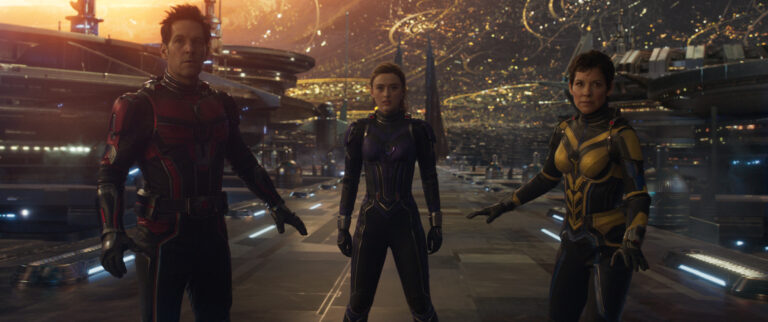Ant-Man and the Wasp: Quantumania (2023 | USA | 125 minutes | Peyton Reed)
Credit where credit’s due, long before any normal human had seen a preview screening of the newest entry in Marvel’s ongoing experiment with serialized cinematic storytelling @jordanjwoodson called it on Twitter:
It’s hard to argue with any of this. I’d found myself pretty gloomy about the state of Marvel over the recent muddle of Phase Four, particularly with the soggy storytelling of Thor, Doctor Strange, and even Wakanda Forever. The latest Ant-Man installation makes small gestures toward levity and a modest leap toward introducing the Next Big Threat for earth’s mightiest heroes to assemble around. A few running gags legitimately made me laugh, some actors transcended the prison of mediocre CGI to make a favorable impression. And since this is allegedly the beginning of a new chapter, it felt less burdened with the responsibility of treading water and shoehorning in ancillary corporate spin-offs, giving the promise of a fresh start. Admittedly faint praise, but I was ready to give up on the whole enterprise, and am now likely to hang around a bit longer to find out what direction this sprawling morass takes. That curiosity is sparked by the promise of seeing more of Jonathan Majors, who (spoiler, maybe?) makes the leap from the genuinely engaging and successful-on-its-own-terms Disney+ series Loki to the big screen as one of many variants of Kang. If we’re going to be stuck with another megalomaniacal adversary for the next few years, I’m glad it’s him.
After a teaser opener in a mysterious gloom, the film opens with a blessed ten minutes in our world catching up with a modern family. Scott Lang (Paul Rudd) has written a book about his part in saving the world as Ant-Man, complete with charming life lesson. As for the rest of the family, when she’s not The Wasp, Hope van Dyne’s (Evangeline Lilly) is consumed now running her family’s magic technology factory while also putting the Pym Particle (or profits derived from it) to … do something humanitarian? Old Hank Pym (Michael Douglas) is using his indistinguishable-from-magic technology to save money on pizzas, among other things. Janet van Dyne (Michelle Pfeiffer), back from her 30 year exile in the Quantum Realm is getting back to normal while acting very strange and not telling anything about the previously-theoretical plane of reality that all of them — most of all her husband — would be intensely curious about having spent his entire life missing her and studying it. And Scott’s daughter Cassie (now played by Kathryn Newton) is this franchise’s precocious teenager. She’s gotten into the family hobby of ant farming and run-ins with the law for misusing corporate shrinking technology in service of protesting police mistreatment of people experiencing homelessness in the suddenly re-crowded San Francisco. Oh, and in her spare time, she and adopted-grandpa have been semi-secretly conducting studies of the pesky ol’ Quantum Realm, mapping it out by sending beacons down there and definitely not mentioning it to the woman who spent decades down there, because doing so would’ve been way too obvious and she definitely would’ve told her not do that.
But had they had a simple but difficult conversation, it’s possible that the movie would’ve been stuck on boring old earth with actual people and environments instead of the convenience of soundstages and CGI, which is how we spend the next two hours. I’ll try not tho harp on it, but every rendered environment that isn’t Avatar: the Way of Water looks like garbage now. But even before James Cameron and the hobbits from Weta revolutionized visual effects (again), Marvel had long since given up on really even trying. They’ve got a very nice set of machines and they spits out sludgy environments and characters that appear to have resulted from giving an AI access to Disney’s vast intellectual property library (welcome to the family, Star Wars). It’s cool that three out of five family members have these techno-magic suits that grant them the very goofy superpower of shrinking to insect-like sizes, return to human scale, and sometimes balloon to gargantuan proportions. Yet, rather than the thrill of playing with scale, it often feels like the primary rationale for these costumes involves a shortcut to keep the film within budgetary constraints. It’s practically a running joke that the heroes click the button on their nanobot suits and have CGI-generated mask appear whenever it’s easier to render a fight sequence without involving performance capture from actual human face. It’s what it is.
With the crew dragged from regular earth into the sub-microscopic we learn a little bit more about this Quantum Realm that appears to have been re-invented on the fly. Rather than the empty void of weirdness that allowed the Avengers to do Time Crimes, it’s now conceived as an entire universe of universes populated by vast wild spaces, hyper-advanced civilizations, and lots of goofy weirdness. It’s mildly fun so long as you don’t try to make sense of any of it.
Much of the action of the film splits the group into its constituent families, with the Langs on a father-daughter quest among a revolutionary faction including a creatures who lets you drink its goo to gain the power of universal translation (and who are very curious about bodily orifices), a psychic who’d rather not know everyone’s disgusting thoughts, a warrior queen revolutionary, and a cyclops cyborg with a thing for torture. Elsewhere, the Pym–Van Dynes traverse the small-i-verse from the wild jungles to a cantina straight out of Lucasfilm. Each side quest features its own cameo, each are indeed pretty funny. It’s nice that these actors, one returning and one newly assimilated into the MCU, have a time even if they’re both playing bargain versions of more interesting characters from better movies. But they’re both good for some laughs, even though we’re not supposed to breathe a word about them or anything specific about their performances.
In his previous Ant-Man films, Payton Reed demonstrated a real sensibility for play and humor and used some of earth’s most charismatic actors to develop characters while also advancing the story. While he fights to keep some of that in there, it’s a shame to see the agelessly charming Paul Rudd, wondrous and cantankerous Michael Douglas, sensitive yet strong-willed Evangeline Lilly, and mysteriously alluring survivor Michelle Pfeiffer constantly reduced to flatter and flatter dimensions, shrunken to the requirements of platitudes that preserve plot reveals for later in the film (or worse, for future films yet to come), or sidelined to the periphery such that their re-appearance on screen comes as both a surprise to themselves and to audiences.
The crime is even more severe for Jonathan Majors as a variant of Kang who’s been long-stranded in the Quantum Realm. Majors is reliably the most watch-able person on screen in anything he’s in and his appearance as a variant of the same character in Loki was dynamic, nuanced, and captivating. Although it’s unfair to expect everyone to have watched everything, I was eager to see expand the role here, but instead it’s a leap backward for the character. There’s a time-weariness to Kang, an eternal exhaustion and a determination, simmering anger and determination. Majors taps into some of this when he can, with conflicting flickers of emotion rippling across his malleable face. But soon enough, he too is buried under a plastic suit that looks like it came out of a Target bargain bin a few days after Halloween and is compressed into a one-dimensional force of antagonistic destruction. My Quantum Kingdom for an emotionally-resonant monologue (or even dialogue) establishing these heroes and villains as multi-dimensional characters who grow, change, or have motivations. Or really, if we’re bargaining, for them to be portrayed anything more than checkers pieces being slid around a board to set-up another series of commercial endeavors.
It’s become a terrible habit, but Marvel’s become reliant on withholding important information from fans and characters alike. Doing so grinds the momentum to a halt rather than allowing characters to develop organically and for the story to play out. Hiding what’s going on is especially egregious here since the film’s opening scene explicitly tells us that Michelle Pfeiffer’s character knows a Kang variant. Keeping everyone in the dark, despite all of these people being very smart and having recently survived multiple reality-bending apocalypses just seems out of character. Similarly, its treatment of the reveal of multiverses as shocking shorthands any substantive discussion of Kang’s motivations. [As a digression, when, exactly, in the Marvel chronology is set is hard to understand and ultimately doesn’t matter because there’s nothing in comics that can’t be ret-conned. An ongoing joke in the Earth-set prelude has regular people — including Ruben Rabasa from that great I Think You Should Leave focus group sketch — confusing Scott with Peter Parker’s Spider-Man, which given the events of those movies suggests that this happens sometime after Avengers Endgame and before Spider-Man: No Way Home.] I’m sure we’ll get to it in three or four movies, but it’s a missed opportunity and makes characters seem deeply incurious and not particularly human.
As solid as Kathryn Newton is as the new addition to the MCU, it’s beginning to feel like Marvel apprised their starting lineup and realized they’re built on a rapidly aging-out boys club. As great as it is to have new heroes, it’s becoming a bit tired that each of its last slate of movies has introduced a precocious teen heroine (great) whose often barely-considered actions (hmm) again and again imperil the fate of the entire universe (yikes) often by virtue of being held hostage and tortured (oof). Even creepier is how it seems at the periphery of the Marvel Cinematic Universe is the idea that maybe the supervillains were right? Earth is still in disarray post-Blip. The return of half the universe’s population has (again) strained resources. There’s little evidence that world governments have responded with any competence, let alone any sign that the planet has in any way re-aligned from repeated alien attacks, frequent destruction of entire cities, the sudden proof of extraterrestrial life, and a giant robot half-hatched from the planet’s very core that sprung up in The Eternals never to be mentioned again. Superheroes are essentially government employees, hereditary royalty, of the beneficiaries of massive corporate power structures that have endowed them with godlike powers. It’s a lot. I can’t tell if it’s lazy or just a sad commentary on our society that most of earth’s population accepts this with a shrug and goes about their life of selling ice creams or over-priced lattes.
I digress … mainly because the film isn’t particularly interested in any of this or giving the new Big Bad a chance to establish himself as much beyond a generic tyrant. Once [things happen] to move him closer to his [possibly] nefarious goals, the action locks right back into the typical template of massive pre-programmed setpieces, chase sequences, and hand-to-hand combat. Again, some credit to Reed for squeezing some humor and pathos as callbacks to previous easy-breezy, light-hearted Ant-Man installations. It wasn’t enough to rise to great heights, but there was just enough for me that it definitely played in a theater.
Ant Man and the Wasp: Quantumania arrives in theaters on February 17th
Header image courtesy Disney.



